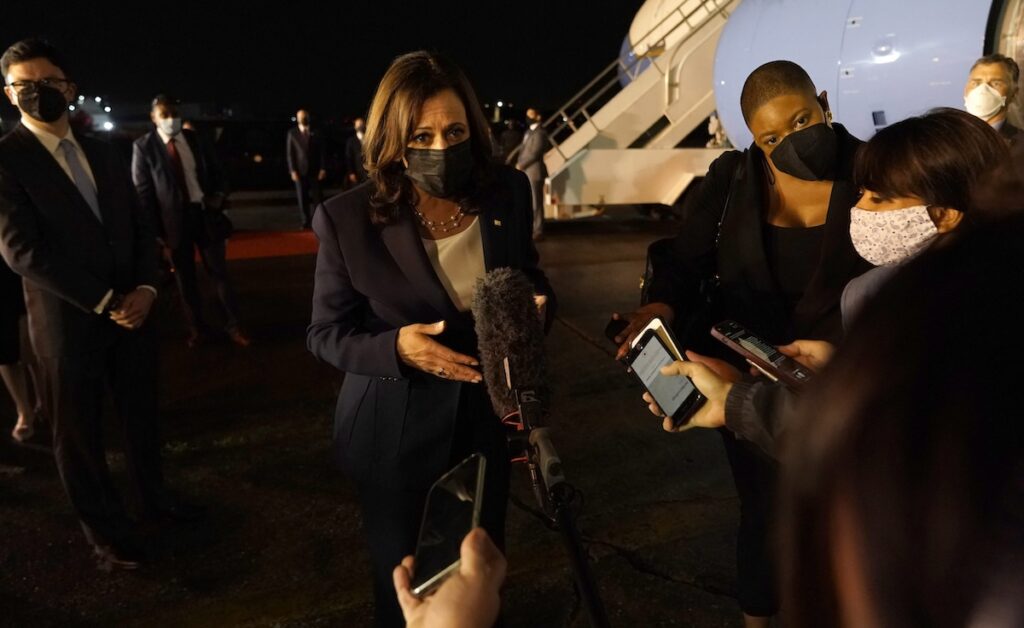When Uriel J. García, an immigration reporter for The Texas Tribune, approaches migrants in hopes of quoting them in one of his stories about the strife along the Texas-Mexico border, he knows he will most likely be rejected. “They’ll almost always say no at first,” he says. In some cases, he’s been able to convince them to share their stories, which is fortunate — he considers these interviews integral to the reporting process, providing that vital human element to pieces that are fundamentally about human suffering and triumph. A recent story he wrote on calls to beef up border security in Texas takes care to extensively quote migrants seeking asylum and their family members.
Without these stories, García says, reporters can easily fall into a habit of simply quoting experts on immigration policy. Human stories risk being reduced to cold political matters; people with often traumatic life experiences are reduced to data and election talking points.
But García can’t blame these prospective sources for shying away from the press. As a Mexican immigrant himself, having grown up in a predominantly Hispanic neighborhood in Phoenix, Arizona, he’s sympathetic to the distrust of his profession. For one thing, he says, “We have a lot to lose if we say something wrong.” Additionally, the press hasn’t accumulated goodwill within the immigrant communities already in the United States.
“I can tell you my neighborhood wasn’t reading the local newspaper — not purposely because the local newspaper was portraying them in a negative light, but in some cases, they weren’t portraying them at all,” recalls García. “When a journalist approaches [an immigrant] and says, ‘I want to hear what you have to say,’ it’s because Trump did something, [or] Biden did something. No one is necessarily asking them, ‘I want to hear what you have to say, because I see you as a member of the community’ … A lot of them are being questioned for the first time publicly about an immigration policy, but for them, why aren’t they being asked about the local elections? Why aren’t they [being asked] about changes in their neighborhood? … They’re just not used to being approached by someone who’s interested in their stories.”
García’s experience, both as an immigrant and an immigration reporter, encapsulates some of the challenges facing this fraught beat at a time when the topic is hounded by inflammatory rhetoric and misinformation. When it comes to immigration, the American public is woefully misinformed. A Pew Research Center study published in 2019 revealed that more than a third of Americans wrongly believed “that most immigrants are in the country illegally.” In fact, as of 2016, about three-quarters of all immigrants in the U.S. are legal residents.
Fear-mongering coupled with the shortcomings of how American media outlets frame the issue — focusing on criminality rather than the human beings behind the statistics and how U.S. policy has helped create the conditions they are fleeing — has resulted in coverage that often whips up fear and offers a narrow view of the immigrant experience. What’s needed instead, say García and other reporters trying to refocus the beat, is coverage of immigration and immigrant communities that reminds audiences what’s at stake — human lives.
What’s needed, say reporters trying to refocus the beat, is coverage of immigration and immigrant communities that reminds audiences what’s at stake — human lives
León Krauze, a Mexican journalist for Univision and a contributing columnist for The Washington Post’s Global Opinions section, wrote a column in March that had some strong words for the English-language press. “The border crisis is about human pain and desperation. Why can’t the media grasp this?” asked the headline. In the piece, Krauze calls the media’s coverage of the border “solipsistic,” consumed by quibbling over the use of the word “crisis” (which should be used, he believes), and argues that reporters are too focused on the political ramifications for the Biden administration. “The reality faced by hundreds of thousands of children, teenagers and parents south of the border should be of enormous consequence in the nation’s immigration debate,” writes Krauze. “But it isn’t, and that’s a shame.”
The reality, Krauze says, is that a combination of “crime, corruption and even climate change” has created an unlivable situation in parts of Central America — a situation worsened by American disengagement. Migrants are fleeing gang violence, police brutality, domestic and sexual abuse, and the devastation of repeated hurricanes. But this is not what dominates immigration coverage in America.
“I think that my colleagues, with a few exceptions, look at immigration basically as a political issue,” Krauze says. “What does this or that policy do to the political balance in Washington? Does this hurt the president? Does this hurt the Republican Party, the Democratic Party? They look at it through a political lens.”
Alisa Zaira Reznick, who covers southern Arizona for the radio station KJZZ’s Fronteras Desk and previously covered the border and immigration for Arizona Public Media, agrees it can be easy to go down a “policy rabbit hole” — something she tries to resist in her work, instead focusing on the communities that will be impacted by the policy in question. This points to the importance of local news in covering immigration; national outlets with reporters parachuting in are more likely to overlook important local angles.
“Part of the benefit and part of the challenge of reporting on immigration locally is you’re not just reporting on a policy change, because NPR is already going to do that,” she says. “Step two is, what does this mean for the communities that I’m covering? What does it mean in Arizona? What does it mean in Tucson?”
In July, Reznick wrote a two-part report on the effect of Title 42, a pandemic-era policy facilitating the mass expulsion of asylum-seekers, and uncertainty around an exemption allowing migrants in particularly desperate situations to circumvent the policy. The report takes readers inside a shelter in the Arizona border town of Nogales, where migrants are offered temporary accommodation and food after being processed. In addition to explaining the policy itself, Reznick underscores the experience of the shelter workers and asylum-seekers. A migrant going by the pseudonym Yessica gives voice to this experience as she is ultimately allowed entry into the U.S.

Some mainstream newsrooms partner with outlets serving immigrant communities. Univision, for example, has partnered with ProPublica both for the latter’s “Electionland” and “Documenting Hate” projects. ProPublica was able to field tips and comments from Spanish speakers through Univision, allowing it to better cover immigrant communities that might otherwise be excluded.
Rachel Glickhouse, partner manager for both “Electionland” and “Documenting Hate,” wrote that these tips helped produce hundreds of stories. The project received more than 35 reports of anti-immigrant incidents and attacks occurring in Walmart stores across the country, resulting in a Univision piece in which employees of the superstore shared how they felt they received inadequate support when confronted with vitriol on the job. Univision also reported on a Spanish-language version of neo-Nazi website the Daily Stormer, which aimed to spread a racist and anti-Semitic message to Spanish speakers and recruit Spanish-speaking volunteers. The site “removed the name of a popular Spanish forum … after legal action was threatened,” according to ProPublica.
The America-centric approach to immigration coverage is compounded by what researchers say is a geographically limited view of the immigration beat, which focuses mostly on the border itself. Krauze points to televised news coverage of Vice President Kamala Harris’ trip to Guatemala and Mexico in June as an example. The trip was an opportunity to delve into the conditions in Guatemala and Mexico, the effects American guns are having on violence in Mexico, and the effects of American foreign policy on the region, as well as the effects of the climate crisis. “There’s a bunch of angles,” says Krauze. “What did [the media] care about? ‘When are you going to the border?’ So that kind of myopic approach, I think, is sadly all too common in American English-language media when it comes to immigration.”
When Internews, a non-profit supporting independent media in dozens of countries, teamed up with immigration newsletter Migratory Notes to analyze the more than 4,500 immigration stories that had been curated in the newsletter from 2017 to 2020, it found that immigration coverage is dominated by stories centering illegality and criminality, in which migrants are being detained or otherwise have no agency.
In addition, coverage tends to revolve around the southern border region, excluding large immigrant communities in states like Florida and New Jersey. Florida, for example, while containing 10.2% of the U.S. immigrant population, was only the focus of 3.9% of 721 location-based immigrant stories examined by the research. And national news outlets based in New York, Los Angeles, and Washington, D.C., dominate immigration coverage, which points to a geographic limitation, per the study.
“There is an opportunity to invest in these communities, which are generally outside traditional landing places and national media centers, and train local reporters in [the] fundamentals of immigration coverage and provide story grants or other incentives to foster coverage,” the study argues.
“Immigration and patterns of migration affect almost every sector of life — think income, schooling, hospitals, public safety, businesses, the type of food we eat,” says Uriel J. García of The Texas Tribune
García also recommends a more holistic approach to immigration coverage, one that gives more attention to immigrant communities already in the United States. “We have to also write about immigration from inside the country as opposed to just the border,” he says. “Immigration and patterns of migration affect almost every sector of life — think income, schooling, hospitals, public safety, businesses, the type of food we eat.” In October, García wrote a piece highlighting business owners along the Texas-Mexico border and how restrictions on border crossings have impacted them. The piece depicts the Mexican-American business owners who sell their wares in border cities like El Paso and Brownsville, where Mexican tourism is an important source of foot traffic.
The Internews study also found that “the reporting of national relevance during the previous administration overwhelmingly highlighted detention, enforcement, the border and the plight of asylum seekers” — a continuing trend, it argued, though the Trump administration made it more severe. There is, in English-language media, a tendency toward using dehumanizing language to describe migrants and migration trends. The word “surge” has become ubiquitous across headlines in mainstream media outlets in describing migrants approaching the U.S.-Mexico border.
Poynter recently argued such language is not only dehumanizing but inaccurate, contributing to an unnecessary alarmism. It’s not just right-wing news sources like Fox News that use this language. NBC News has described migrants as “flood[ing] the southern border”; NPR has referenced a “surge of migrants.”
Reznick from KJZZ’s Fronteras Desk says she avoids such language herself because these word choices impact the way readers receive information about an already controversial topic. “It’s going to change what your piece looks like if you say migrants are ‘flooding’ the border or there’s a ‘surge’ of migrants at the border,” she says. “Those things look small, but they’re extremely consequential in the way people read your work. The people reading these stories might be people who have never seen the border, or ever thought about the border.” A journalist’s coverage can make the difference between those people viewing immigration as a remote, even hypothetical policy issue versus seeing it as an issue impacting real people.
Also front of mind for Reznick is the climate of alarmism and fear-mongering in which she is reporting. It’s difficult to ignore and influences how she thinks about her job. “If anything, it makes you hypervigilant not just about what you’re saying but how you’re saying it,” she says. Indeed, right-wing media pundits like Tucker Carlson of Fox News have perpetuated anti-immigration conspiracy theories about white extinction and speak of immigration in an alarmist manner, claiming immigrants are coming to “plunder” America and are making America “poorer and dirtier.”
Aside from such plainly racist rhetoric, Fox News has sounded the alarm about “COVID-positive migrants” (despite otherwise dismissing the seriousness of Covid-19 and trafficking in harmful vaccine denialism), contributing to the baseless theory that migrants are driving case counts. Then there is the false claim, perpetuated by Fox News, that Biden has pursued an “open borders” strategy that has driven an increase in migrants arriving at the border.

The deluge of misinformation and sensationalist rhetoric can create added pressure, as some immigration reporters see their role as, in a way, a counterbalance to the very loud hyperpartisan sector of the media making these false claims.
Hamed Aleaziz, who covers immigration for BuzzFeed News, feels the best way to deal with misinformation is to simply do one’s own work as well as possible and not worry about what response it might elicit from bad actors. “I focus on trying to stick to the facts and to tell stories that break news on upcoming policy changes, or shed light on problems with how the government is implementing policies or handling people, and to speak to the people who are more impacted by these policies,” he says. “Sometimes this work can be used to shape a political agenda, but I think ultimately focusing on those factors and treating each story with nuance and rigor is the best path. I think it’s smart to always counter any misinformation with focusing on facts; that helps build a relationship of trust with our readers.”
It’s also important to be cautious when quoting sources who spout misinformation, notes García. “I think it’s important to contrast a politician’s claims on immigration to actual facts,” he says. “For example, if you quote someone saying that the border is wide open, I think it’s important to note that [the] majority of the undocumented people living in the U.S. had come here legally, overstaying their visas. Or, that the Biden administration has continued two policies — MPP and Title 42 — that essentially block many asylum-seekers from entering the country.”
And drawing attention to real immigrant stories can go a long way when it comes to detracting from fear-mongering narratives. “Ultimately, the best way to debunk a lot of the false narratives is to highlight immigrants’ stories by giving them a platform to speak for themselves,” García argues.
Plus, it’s not just right-wing news sources that will fumble the framing of an immigration story; mainstream outlets have also contributed sensationalist or misleading journalism. “If you watch TV news or listen to pundits, or half of Congress, you think Joe Biden flung the gates open and there’s a million people and they’re all being let in,” says Gaby Del Valle, who writes Substack newsletter BORDER/LINES with fellow immigration reporter Felipe De La Hoz. “It’s not happening.”
Drawing attention to real immigrant stories can go a long way when it comes to detracting from fear-mongering narratives
And those outlets that spread misinformation have an attentive audience. According to the Pew Research Center, immigration was one of the most-covered topics during the early days of the Biden administration across 25 major news outlets but was especially dominant in outlets with a right-leaning audience. Those right-leaning readers were also more likely to want even more coverage of immigration. This complements a 2018 research study from Pew, which found “illegal immigration [was] the highest-ranked national problem among GOP voters.” This view is likely encouraged by the fear-mongering from outlets like Fox News, which, in turn creates a greater demand for such content: News consumers are told disease-carrying migrants are coming to “plunder” their country, then become eager for updates on this apparent crisis. President Trump contributed to this rash of misinformation before the 2018 midterms when he falsely described migrant “caravans” arriving in the U.S. as largely comprised of criminals who have “injured” and “attacked” people.
Del Valle and De La Hoz launched the weekly dispatch BORDER/LINES to provide a thorough and digestible breakdown of a whirlwind of policy changes. The decision to launch a guide to immigration news came amid a moment of confusion, says Del Valle, when photos of migrant camps on the border spawned finger-pointing that was missing vital context. “People would be like, ‘This is Trump’s immigration policy,’ and people would be like, ‘Actually this is Obama’s immigration policy, too,’” she recalls. “My reason for founding the newsletter was to contextualize what seemed like new, cruel policies — not to let the Trump administration off the hook, but to show how deeply entrenched all of this stuff is, how it’s not necessarily the product of one person’s ideology but decades of congressional funding and bipartisan agreement that only suddenly has become really politicized.”
Last September, the newsletter took on the heavily covered story of the Haitian migrant encampment in Del Rio, Texas, which drew attention for its size, squalor, and the harsh response from Border Patrol. BORDER/LINES broke down the fraught history of Haitians seeking asylum in the U.S. — how for decades Haitian migrants have been largely barred from claiming asylum status, instead categorized as “economic migrants,” because the U.S. was avoiding acknowledging its role in a humanitarian crisis there. (The government was materially supporting dictator François Duvalier, who was in power from 1957 to 1971). The newsletter also explained the narrow perimeters of the “asylum” category, explaining that most of the Haitians did not technically qualify.
“All news coverage of immigration, by virtue of being news coverage, has a bias towards the new,” says Del Valle. She hopes that by providing deeper context on what came before, she and other reporters can foster a better understanding of what is happening now.




